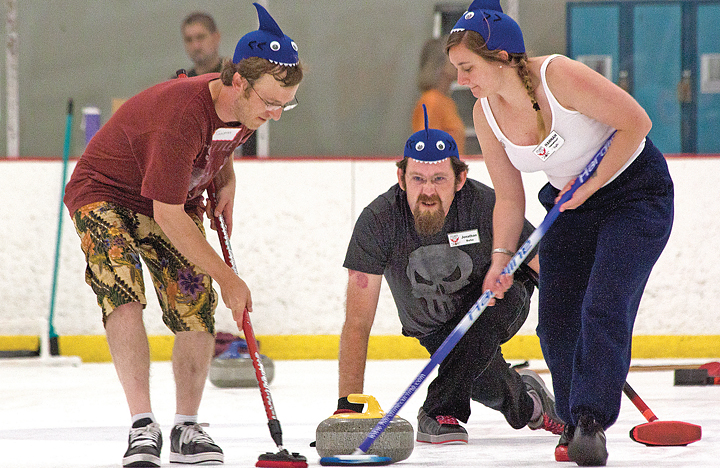As the unrelenting sun baked the Cape Fear region June 20, Wilmington hosted a tournament on ice.
Around midday, the frozen rink in the Wilmington Ice House echoed with a variety of noises: the scrape of 40-pound stones sliding across the slick surface, the shouts of teammates guiding the rocks across the rink and the crack of stone hitting stone.
For the fourth year, the rink hosted the Coastal Carolina Curling Club’s Lighthouse Beach-Spiel.
Sixteen teams of four played three matches each throughout the day, accumulating a total score based on games won and points scored. After the final match, the team with the most points earned the first-place lighthouse trophy.
Two teams represented the Coastal Carolina Curling Club (CCCC), but the others came from across the state or farther; four teams traveled from Georgia, one from Maryland and one from the Great Lakes region.
Most ice rinks shut down in the summer, local player John Wojciechowski said, so Wilmington’s beach-spiel gives members from other clubs the opportunity to play during the offseason. During the winter, many of those clubs also host tournaments, called bon-spiels, to which CCCC players often travel.
The matches are competitive and the tactical nature of the game requires players remain focused on the ice. But the sport has an equally important social aspect, Wojciechowski said.
After every match, team members shake hands, a common practice in most sports. But curlers go one step further. The two teams always sit down together after the game to get to know one another and share a few drinks, Wojciechowski said. It’s such a vital part of the sport, it has a name: broomstacking. The game would also not function without sportsmanship and etiquette, he added, pointing out the absence of referees on the ice.
Because of the limited space on the rink at the beach-spiel, teams alternated playing and broomstacking. Eight teams gathered around the rink’s perimeter, watched the four games played and cheered on teams with beach-themed costumes and creative team names like “Groom-stacking,” “Swept Together” and “Curlabunga.”
In the game at the far end of the ice, as a woman with greying hair released a stone to glide toward the target, or “house,” two sweepers ran on either side of the rock, scrubbing the rough ice in the rock’s path with brooms to guide its trajectory. The team captain, or skip, stood behind the house, shouting instructions to the sweepers.
One of the greatest aspects of curling, Wojciechowski said, is the age range of players. One of CCCC’s curling teams contains three generations of the same family.
“What other sport will you see a 14-year-old and an 80-year-old on the same team?” he said.
The beach-spiel is an opportunity for CCCC players to test their skills, but the club also holds Learn to Curl events throughout the year to introduce others to the enigmatic sport most Southerners only glimpse every four years on winter Olympic highlight reels.
“It’s a sport for people looking for something different,” Wojciechowski said. “Or maybe they’re older, and they’re looking for something they can do…but you’ve got to embrace the social aspect of it too, and understand that this is just a bunch of friends and we have a good time together.”
email [email protected]




